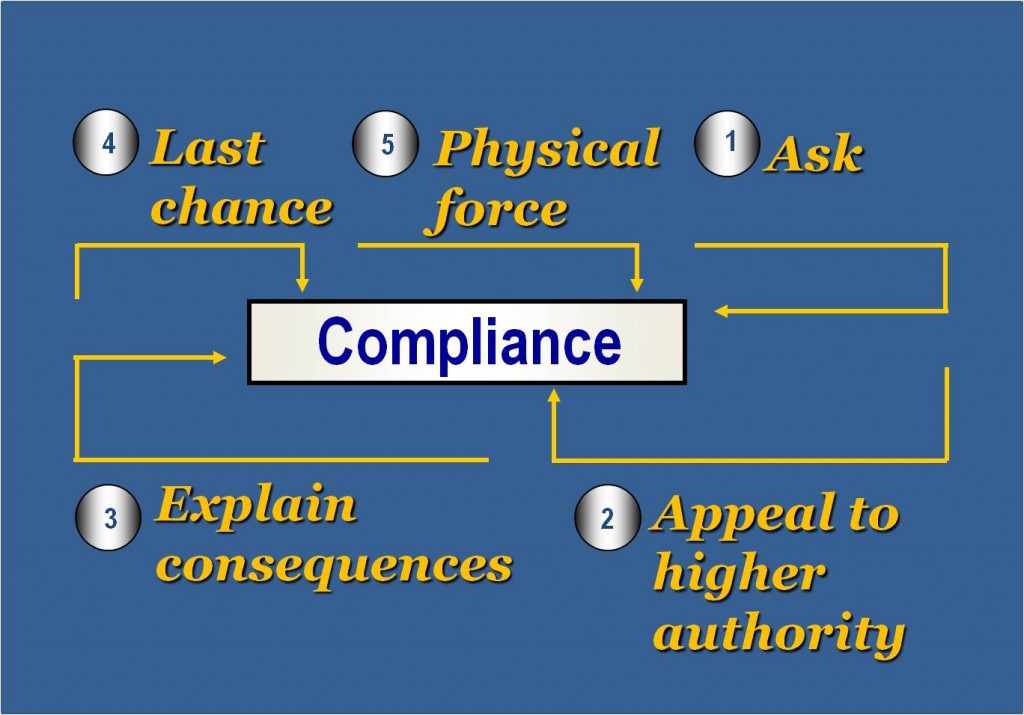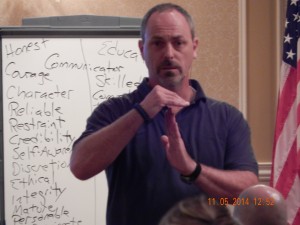Category Archives: Dynamic of Compliance
In this last installment of the Dynamic of Compliance, I wrap up the entire lesson into a 5-step professional standard of conduct that can easily be utilized in the field.
Similar to the 5-Step Hard Style Kata of the Verbal Judo program, following this pattern should result in a higher level of voluntary compliance and a lower incidence of physical force. By following a professional pattern of conduct, law enforcement officers can protect themselves from claims of excessive force, media criticism, disciplinary actions, internal investigations, litigation, endless depositions, risk of injury, exposure to bodily fluids, and mounds of paperwork, not to mention tons of aggravation and stress!
Amateur Hour…?
Many of you have seen this video from Code3TV.com of an officer dealing with a challenging individual, who happened to be a 77-year old woman with a weak bladder, during a car stop. I always hesitate to second guess an officer in the field, but I can’t help but wonder if the outcome would have been different had the officer followed this 5-step process before resorting to physical force…
Graphically, the Dynagram for this Dynamic looks like this:

Time and circumstances permitting, you should utilize this pattern every time you encounter a difficult individual who challenges your authority.
If you found this lesson helpful please share it with others by clicking
one of the Share the Knowledge buttons below…
The Scorning and Steadfast Offenders present the greatest challenges of the Five Types of Offenders. They will put your tactical communication skills to the test…
The Scorner needs Confirmation in order to voluntarily comply. He wants to know the answer to the question “Are you really serious about this…?” before he will agree to comply with your lawful commands. So your action is to give him a Last Chance with the following phrase developed by Dr. George Thompson of the Verbal Judo Institute:
“Is there ANYTHING I can say or do to gain your cooperation…
just for tonight?”
Notice the emphasis on the word “ANYTHING.” Your phraseology and voice inflection are critical to delivering the message effectively. It should come across almost as a plea for compliance, but it is their last chance. Anything other than a reasonable request, which you might consider granting if circumstances permit, or immediate compliance takes you to the next level, PHYSICAL FORCE.
If the subject resists up to this point, it likely means you are dealing with a Steadfast Offender, the highest level of offender. He needs Isolation and wants the answer to the question, “Can I make a phone call…?” In other words, he’s going to jail! Steadfast Offenders need incarceration, so if you have the appropriate legal grounds, you should consider making an arrest. But in all likelihood you will have to resort to the THREAT of physical force, with the apparent immediate ability and intent to carry through, or actual force in line with your policy and the Use of Force Continuum.
The tactical communication phrase above is designed to alert your partners that physical force is imminent so they can position themselves and get ready.
“When words fail, ACT!”
A.C.T. is an acronym for Aggression Control Tactics, a police self-defense program I put together a number of years ago. But the bottom line is that you have now exhausted the opportunities for voluntary compliance and must resort to your arrest and control tactics.
If you enjoyed this lesson please share it with others by clicking
one of the Share the Knowledge buttons below…
The Sensual Offender wants to know “What’s in it for me…? In other words, they need Mediation to help them see that it is in their best interests to comply. In Part 2 of the Dynamic of Compliance, we discuss how to generate voluntary compliance by using Verbal Judo to “cut across” the experiences of the offender.
If the driver of a vehicle which you have lawfully stopped refuses to surrender his driver’s license, even after you have asked for compliance and appealed to a higher authority, it likely means that you are dealing with a Sensual Offender (at least). He is not likely to comply unless you can convince him it is in his best interests. So you might say something like, “If you don’t comply, let me tell you exactly what is going to happen next. First of all, I will have to arrest you. Secondly, if you resist, I will call in whatever backup is necessary. You will spend the night in jail and miss being at home with your family. You might even miss work tomorrow. Then you will have to pay a bondsman, hire an attorney, and end up with a criminal record. Plus we will have to tow your car. Now, do you really need that kind of trouble tonight…?
Dr. George Thompson, founder of Verbal Judo (to whom I give much credit for the content of the Dynamic of Compliance), calls these “hooks.” Just like a fisherman casting a lure, you may have to try several before you find the one that works. Each one is designed to show the driver the consequences of his failure to comply. At this point, we don’t know which one he will “bite” on so you have to have several hooks ready to go. While he may not be intimidated by the possibility of going to jail, or of missing time with his family, he may realize that he can’t afford to miss work. Or maybe he just doesn’t want a tow truck driver touching his car!
The same technique can work against a stubborn inmate who refuses to come out of a jail cell for an inspection. You might say, “If you don’t come out, I’ll have to send in the extraction team. They will use pepper spray or a Taser if necessary. Then you will be placed in disciplinary segregation or maximum security. Next you will lose your commissary and visitation privileges. Now do you need that kind of trouble tonight…?” The inmate that uses pepper spray for seasoning on his food is not afraid of a good fight. But maybe he was really looking forward to getting that Moonpie and Mountain Dew from the commissary tonight! Or maybe he was counting on seeing his family for visitation on Sunday afternoon. That’s the hook that you will use to reel him into compliance.
In the next sessions we will look at dealing with the remaining types of offenders, Scorning and Steadfast Offenders, then put the whole thing together into a professional pattern of conduct that will help protect you, your agency, and your fellow officers from harm or litigation.
If you enjoyed this lesson please share it with others by clicking
one of the Share the Knowledge buttons below…
In the Dynamic of Discretion, we identified the Five Types of Offenders. In this series on the Dynamic of Compliance, we look at how to overcome challenges to lawful authority by answering some basic questions.
The fundamental goal of law enforcement is to generate voluntary compliance with the law. Each of the Five Types of Offenders will respond to your authority slightly differently depending on how you answer a basic set of questions. Even if they don’t vocalize it, they are likely asking it.
The late Dr. George Thompson, founder of Verbal Judo, was instrumental in helping me formulate this Dynamic. Many thanks go to him for his influence on me, Police Dynamics, and law enforcement officers throughout the world.
Simple Offenders need an Education. They want to know the answer to the question “What?” as in “What do you want me to do?” They are generally not much of a challenge to law enforcement because they will typically comply if you simply tell them what you want them to do and then ask them to do it.
Silly Offenders are more of a challenge. They will rarely comply on the first request. They need an Explanation. They want to know “Why?” “Why should I have to comply?” “Why do I have to listen to you?” This is where many police officers and corrections officials make a crucial mistake. They answer something like, “Because I said so, that’s why!” And they just blew it! They turned a routine challenge to authority into an ego battle, and they may very well have to resort to physical force before it’s all over. That response doesn’t even work well at home! Do you expect it to work well on the streets?
The professional law officer has learned to put his ego aside and appeal to a higher authority. In other words, it has nothing to do with what I say. It has to do with what the law says, or what the policy says. By setting your ego aside, appealing to a higher authority, and answering the question “Why?” effectively, I believe you can generate voluntary compliance with the vast majority of individuals you deal with. In the next session, we will examine the Sensual Offender and learn how to answer the question, “What’s in it for me…?”

